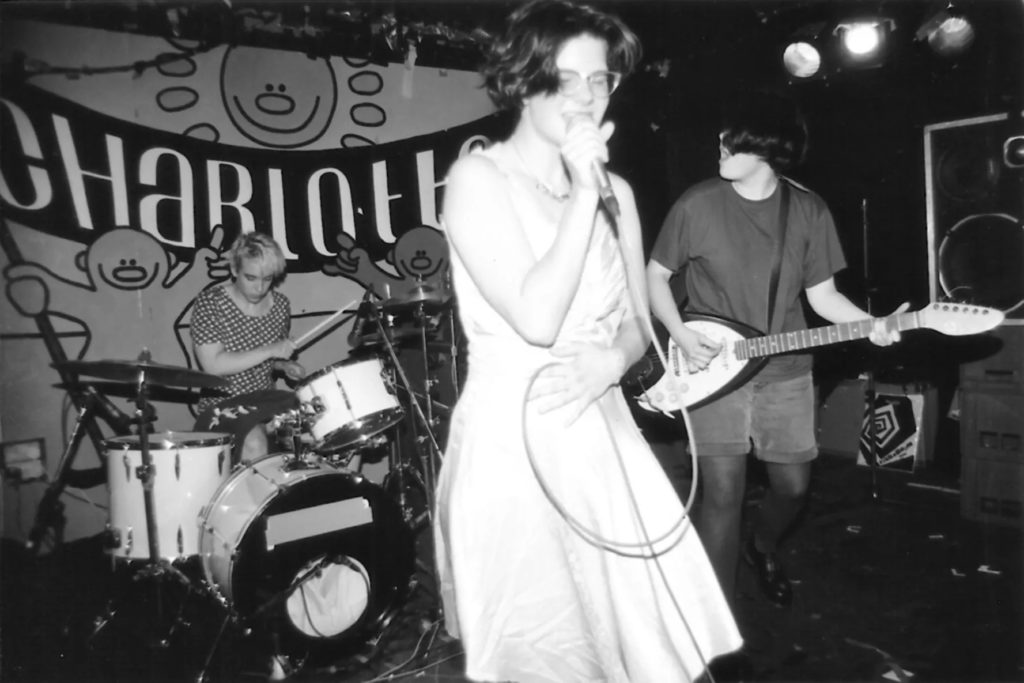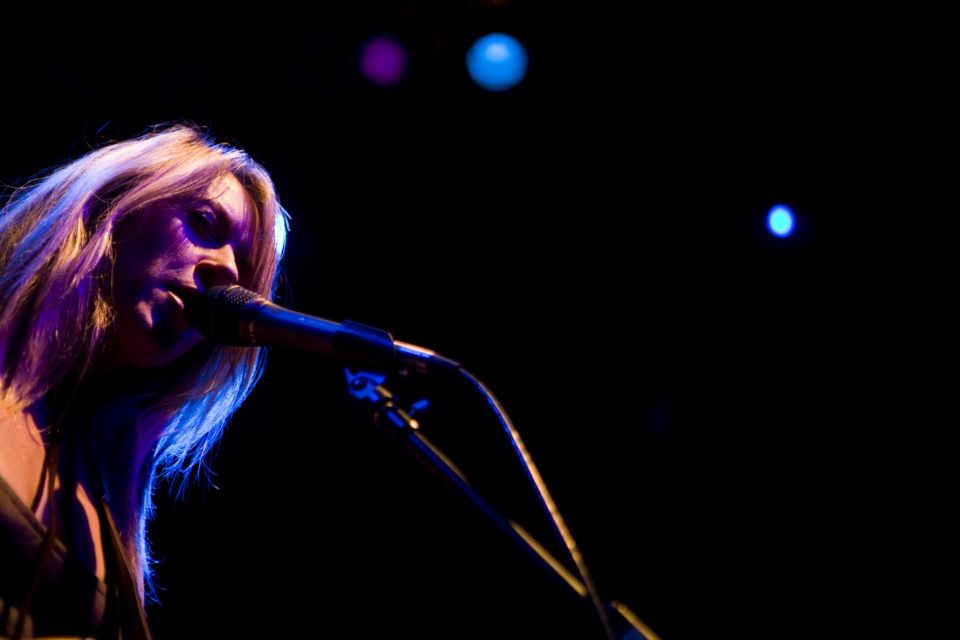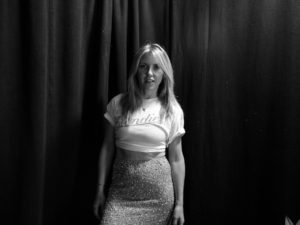By Zach Schonfeld
Newsweek Magazine, May 18, 2018
Tae Won Yu received a cassette tape in the mail. It was 1991, an era when bootlegs flowed freely through the postal service like pollen in springtime. Vanilla Ice had the top-selling album in America, and Nirvana was months away from breaking through to the mainstream, but the underground scene was vibrant. Yu, then the guitarist for a rock duo called Kicking Giant, frequently received homemade tapes in the mail from musicians in the indie-fanzine world: Bratmobile. Bikini Kill. Daniel Johnston.
This particular cassette was special. The songs, bracing and raw, had been recorded at home by Yu’s friend, an unknown 23-year-old songwriter named Liz Phair. “It was astounding, and fully formed—both the sound and the ease of her lyrical dexterity,” said Yu. “I felt very lucky, and also very jealous of my friend, who was such an accomplished songwriter.”
Pretty soon, on the strength of that tape and several others, Phair would be a rising star, and then a Gen-X icon.
For more than 25 years, Phair’s early tapes, recorded under the name Girly-Sound and commonly known as the Girly-Sound tapes, have circulated among fans, first in analog form and then as digital files, amassing a reputation as the holy grail of alternative-era bootlegs. Exile in Guyville, Phair’s 1993 debut, is widely hailed as her masterpiece, but those tapes introduced its most crucial songs and provided the crude road map for her career. Now, after decades of semi-legitimate circulation and word-of-mouth mythology, the complete tapes have been commercially released for the first time, compiled in Girly-Sound to Guyville, a boxed set honoring the 25th anniversary of Exile in Guyville.
This is the story of how those homespun cassettes launched Phair’s career, landing her a record deal (with some serendipitous assistance from Yu), and how they developed a peculiar life of their own. It is also a story of how talent could be spotted in ways both primitive and miraculous, long before the advent of Spotify playlists.
The story begins at Oberlin College, where Phair studied visual art during the late 1980s and where her childhood interest in music blossomed. “Everyone had a band,” she recalled in a 1994 profile. (Phair was not available to be interviewed for this piece.) “There was a lot of rock ‘n’ roll spirit, but it was an intense place.” It was there that she met a young musician named Chris Brokaw, later of the bands Come and Codeine. “She was dating someone I knew,” Brokaw recalled. “She was just my friend’s girlfriend.”
In 1989, during Phair’s junior year, she spent time in New York interning for the artist and activist Nancy Spero. Two crucial things happened there: Phair wrote a ton of songs, and she befriended Tae Won Yu, a kindred spirit attending Cooper Union nearby. “She was like a sister or a best friend almost immediately,” said Yu. “I felt like I’d known her all my life.” They both lived in the East Village and shared an interest in music, though Phair remained secretive about her songwriting. Yu remembered “a lot of beer-drinking and record-listening.”
After graduation, Phair decamped to San Francisco, and Brokaw happened to be friends with her roommate. When he spent a week crashing at their loft in late 1990, he became closer with Phair. “I saw that she had a guitar in her room,” Brokaw said, “and I was like, ‘Oh, I didn’t know you played music.'” Brokaw told her about his band Codeine, which had recently released its first album, and Phair asked him to play her a song. “So I played a song and I was like, ‘Play me one of your songs.’ And she played me a song and it was great. I was like, ‘Man! Play me another one.’ So she played me another song and I said, ‘Wow, your songs are great. Would you make me a tape of your songs?’ And she said, ‘Sure.'”
A month later, when she moved back into her parents’ house in suburban Chicago a month or two later, the 23-year-old Phair kept her word: She made a tape.

The first Girly-Sound cassette, recorded in late 1990 or early 1991, contained 14 songs and was cheekily titled Yo Yo Buddy Yup Yup Word to Ya Muthuh. The second tape, Girls! Girls! Girls!, made a month later, had 14 more songs. Both tapes had an invigorating sense of emotional and sonic intimacy. Phair recorded straight to a four-track recorder. “I was just making up crazy little songs in my bedroom,” Phair said in a recent interview with Jezebel. Production values were nonexistent. Her vocals, double-tracked over a barely amplified guitar, were low and wobbly and untrained. At times she sang quietly, like a teenager who didn’t want her parents to hear her from the next room.
Yet there was nothing timid about the lyrics, which confronted sex, rejection and desire with startling frankness. By 1993, Phair had an audience enraptured by her ability to speak plainly to the vulnerabilities and indignities of being a young woman whose wants and needs are unfulfilled. (The beloved example is “Fuck and Run,” the indelible anthem whose fed-up narrator swears off casual sex and declares: “I want a boyfriend / I want all that stupid old shit, like letters and sodas.”) But in early 1991, Phair had no audience; she had friends. And she mailed copies of that first tape to two of them: Brokaw and Yu. That was followed by the second, then a third tape, Sooty, which featured an early version of the gloriously profane “Flower,” in which Phair inverts the male gaze and fantasizes about having her way with a shy male crush.
Brokaw was immediately impressed. “There was an urgency and a directness about the lyrics that you find in literature and in films, but it was pretty rare to find it in rock music,” Brokaw said. “And it was certainly rare to hear from a female voice.” The tapes revealed Phair’s blunt sensibility—and her humor: She experimented with goofy voices on “Elvis Song” and cartoonish accents on the spoken-word gem “California.”
Brokaw made copies of the tapes for his sister and his then-manager. Yu went further: He made dozens of copies—”I daresay over a hundred,” he estimates. “He thought she was a genius,” says Brokaw, “and I don’t know what possessed him, but he sent these tapes everywhere.”
There was no aim to profit. It’s important, Yu said, to understand the anti-corporate, cassette-sharing ethos that flourished back then. “A very engaged community of people communicated through mixtapes and tapes,” he said. “We were rejecting the idea of waiting for a label or corporate backing to be ‘legitimate.’ Have you heard this amazing thing? was the subtext behind much of our correspondence.”
At the time, Yu was in regular touch with underground artists and DIY punks across the country. They exchanged postcards, tapes, zines: the noncorporate music press that flourished before blogs. He introduced them to Phair’s music. “I sent it beyond my circle of friends, to Calvin Johnson [of Beat Happening] and Mark Robinson [founder of TeenBeat Records].”
Another recipient was Allison Wolfe, the lead singer of Bratmobile, part of the pioneering feminist punk movement Riot Grrrl. When she heard Girly-Sound, she was blown away. “Her lyrics were so explicit,” said Wolfe. “I thought she was so good at skewering the double standards between men and women. She was singing about alternative guys and saying how they’re the same old sexist jerks as anywhere else.”

Wolfe brought the tapes to the West Coast when she was a student at Evergreen State College, and put the song “Open Season” on mixtapes. Her punk friends weren’t impressed. But one day, as she was buying food at the “hippie cafeteria,” a collectively run on-campus café, a student worker approached her with a request: “I heard you have these Liz Phair tapes… Can I please dub them?”
That student was Mirah Yom Tov Zeitlyn, an 18-year-old musician who would later achieve indie fame under the name Mirah. Wolfe returned to the café one day and handed Mirah a cassette tape—carefully, as though it were a precious jewel. “I loved every word, every song and every sound,” Mirah recalled in an email. “That tape is what made me determined to train my little hands to play bar chords, and it impacted my songwriting, too. I played it for everyone I knew. I’m sure I made copies for people. I had a circa-1992 tape-to-tape cassette recorder in my dorm room that got a lot of use in those days!”
Phair’s tapes zigged and zagged through the underground, becoming popular in the zine universe. At some point, Yu wrote an effusive review of Girly-Sound for the fanzine Chemical Imbalance. (The review included Phair’s home address and implored readers to “send her some cash for a tape.”) “I really wanted the world to know about this brilliant talent,” he said. “Liz, from what I could tell, was simply writing these songs and didn’t know what to do with them.”
By Phair’s own account, that was an aimless period for her. She had stage fright, rarely if ever performing live. “I was living this completely post-college, flat-broke, only-cared-about-going-out-at-night existence,” she later told SPIN.
Through a friend she met Brad Wood, who would become a trusted collaborator and produce her eventual album. Wood told Phair, “You need a label.” On a whim, she dialed up Matador Records in New York. Her timing was miraculous. “I get a lot of silly, audacious calls,” Matador co-owner Gerard Cosloy told the New York Times in 1994. “But the day before, I’d read a review of a Girly-Sound cassette in Chemical Imbalance.” It was, of course, Yu’s review. The label was intrigued.
“An Unexploded Bomb”
If you’ve read this far, you know what happens next: Phair got signed. She got famous. She got widely imitated and debated. Exile in Guyville (much of it adapted from the Girly-Sound tapes) was instantly revelatory and widely acclaimed.
But even as Phair graduated to professional status, with a label and a band, she kept returning to Girly-Sound. Over the years, she has described the Girly-Sound tapes as a sort of personal vault she could rummage for song ideas and sketches. In 1994, when her second album, Whip-Smart, came out, Phair appeared on the cover of Rolling Stone. The subject of the tapes arose in the corresponding profile. “I go in there and rip stuff off,” she explained. “It’s like a library.”
Indeed, Phair spent years tweaking and reusing songs originally documented on those tapes. Nine Girly-Sound songs wound up on Guyville with fuller arrangements and, in some instances, new titles. Five more appeared on Whip-Smart, and two more on 1998’s whitechocolatespaceegg. (There was also the Juvenilia EP in 1995, which featured five songs that originated on Girly-Sound.) Only in the new millennium, when Phair tried to remake herself as a glossy pop singer on a polarizing 2003 album, did she leave her early work behind.
The 1994 Rolling Stone piece reported that Phair “[would] not release the tapes anytime soon.” Back then, she seemed somewhat embarrassed by the hyper-personal and unpolished nature of the collection.

But her unwillingness to make the recordings officially available only contributed to their mystique. It was exciting for fans to hunt down semisecret tapes that only the select few had access to (“You had to know someone who had it to get it,” said Mirah). Much as Exile in Guyville was sequenced as a track-by-track response to the Rolling Stones’ Exile on Main St., the Girly-Sound tapes could also be slotted into a classic-rock tradition: the sought-after bootleg. For boomers, it was Bob Dylan’s Great White Wonder and the Beach Boys’ aborted SMiLE album. Gen-Xers had Girly-Sound.
“If albums are the signposts of rock history, bootlegs are a portal to rock’s shadow history,” Steven Hyden wrote in his new book Twilight of the Gods: A Journey to the End of Classic Rock. “The only music greater than the music that moves you is the music you’ve been told over and over would move you if only you could hear it.”
Thankfully, plenty of people did hear the Girly-Sound music. As Phair’s profile rose, the tapes spread far beyond Yu’s underground network of collectors. “You can imagine the contrast between Liz as she existed in the early ’90s on the cover of Rolling Stone versus a very quiet voice singing incredibly heartfelt songs into a tape recorder,” said Yu. “The idea of these incredibly pregnant songs existing, unknown, without a label on a cassette—it was like an unexploded bomb.”
In the mid-’90s, the tapes made the jump to compact disc: A Phair fan named Patrick began selling poorly dubbed CD-R copies from his apartment in San Diego. He drummed up interest on the alt.fan.liz-phair Usenet group, then sold them for about $25 apiece to cover the cost of discs and shipping. He called his bootlegging operation Bliss and Fetish, but it was never a legitimate label, as Wikipedia seems to suggest.
“It was just something I ran out of my apartment,” said Patrick, who asked to be identified by first name only because of the questionable legality of his bootlegging past. “I finished college, and instead of paying off my [loans], I bought two CD burners and 200 blank discs. And that cost me $3,500… I focused on B-sides and unreleased material, and via the internet I would say, ‘Hey, is anyone interested in these?'”
A handful of fans wanted the Girly-Sound discs, but those who received them soon realized the quality was degraded. “They sounded terrible,” Patrick admitted. “The tapes that I got ahold of were probably seventh- or eighth-generation. And there was so much hiss on them.” Worse, the track list was an incomplete selection from all three tapes.
Yet the discs mysteriously multiplied. Within a few years, Patrick started seeing Girly-Sound discs pop up for sale on eBay. He could tell from certain quirks that they were sourced to his own copies. Once, he spotted a copy for sale at a San Diego record store; he huddled in a listening station to confirm it was from his dub.
By 2006, the tapes were 15 years old, and bootleg culture had shifted from CD-trading to file-sharing. Ken Lee, a self-described Liz Phair archivist who founded the Phair fan site Mesmerizing in 1997, managed to obtain low-generation dubs of the first two Girly-Sound tapes. Lee made them digitally available to fans on girlysound.com, but the third cassette tape was missing. The site desperately urged fans to aid in the search for it: “They gotta be out there somewhere, doing time as squeegees, as drink coasters… or in some equally noble station. So PLEASE (with fucking candy sprinkles on top) LOOK for them!”
By that point, Phair’s views on releasing the tapes seemed to have evolved. Her career had come full circle, and in 2008 she reissued Guyville for its 15th anniversary. In an interview with Pitchfork’s Stephen Deusner, she mused about passing out the Girly-Sound tapes for free, “just like they were originally.” When Lee hand-delivered the singer CD copies of his dubs, “she was OK with it,” he said. “She asked if I made any money off of them. I never did, as it was a labor of love for me.”
Subsequently, Phair included 10 Girly-Sound tracks as a bonus disc with her 2010 album Funstyle. In recent years, the tapes have influenced an entirely new generation of songwriters, some of whom were not yet born when they were recorded. “I would say that they are why I write music,” Lindsey Jordan, the 18-year-old musician who records under the name Snail Mail, recently told Phair. “They’re so honest.”
In 2017, while preparing to release the full recordings, Matador asked Yu to dig out the original tapes. He still has a boombox and found himself listening to them for the first time since the late ’90s. “They’re still incredible,” Yu said. “The freshness still hits me.” Back then, the tapes were was a coveted gem. Now, with the arrival of the Girly-Sound to Guyville boxed set—and the larger cultural shift from physical media to streaming—hearing the songs, recorded in Phair’s bedroom, is as easy as sending a tweet.
What is entirely gone is the community that nourished the tapes and helped create Phair’s career. “I miss the kind of sharing that included human contact,” said Mirah. “Listening to Girly-Sound felt like being a part of something, and it felt good.”
Featured Image: Liz Phair performs her album “Exile in Guyville” at the 9:30 Club in Washington, D.C., on August 28, 2008. (Photo: Brendan Hoffman / Getty Images)










